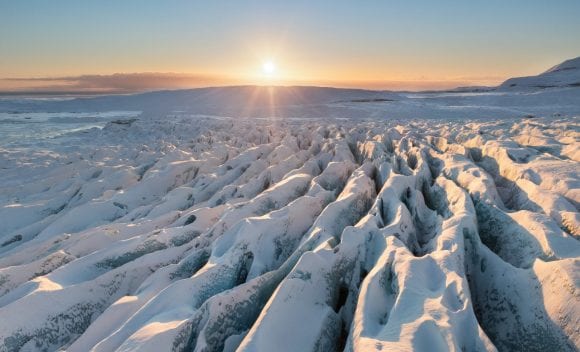Article
Arctic crocodiles
50 million years ago crocodiles lived above the arctic circle. Without serious climate action, they could reappear near the northern hemisphere’s doors, along with more serious consequences.

50-million-year-old crocodile bones were found on Canada’s northernmost island, Ellesmere.1 Crocodiles living above the arctic circle sounds far-fetched—they usually thrive in hotter climates—but with temperatures rising, it could become a reality; yet another unintended consequence of global warming and an additional reminder that we need to commit to understanding and addressing climate change.
At the 2015 UN Climate Change Conference, 196 parties signed the Paris Agreement to limit global average temperature increases to 1.5°C above pre-industrial levels2—not only to keep the crocodiles from reaching the gateway to the arctic, but to prevent more widespread ecological damage. Yet, to many, it’s still not clear why the world agreed on this threshold and why halting global warming is relevant for human prosperity.
There is no one temperature
There is no one temperature
Globally, temperatures vary significantly based on geographical, seasonal, and other factors. In fact, at any given moment, the coldest and warmest places on Earth are likely to be more than 55°C apart.3 To analyze temperature changes and assess long-term trends on a global scale, scientists began taking measurements all over the planet and developed the Global Mean Surface Temperature (GMST), more commonly known as Earth’s “average temperature.”
The results show that the last few years have been the warmest since measurement began in 1850, with GMST rising by more than 1°C compared to pre-industrial levels, putting us on track to not only breech the Paris goal but to significantly exceed it.4
The long-term average temperature depends on the amount of energy the Earth receives from the Sun minus the amount it radiates back into space. While the energy from the Sun is relatively steady, our atmosphere tends to retain a little more every year as it accumulates more greenhouse gases (GHGs).5 GHGs take their name from the fact that they allow sunlight into our atmosphere, but then trap this energy, thereby heating up the surrounding air like in a greenhouse.6 This effect, however, is not equally strong around the globe. Developments in recent years show that arctic areas and land in general are more prone to warming, while parts of the Pacific Ocean have even cooled down.7
Despite permanent temperature fluctuations and considerable regional divergence, aiming for a maximum of 1.5°C warming has become a broadly accepted target in climate change discussions. According to an Intergovernmental Panel on Climate Change report, failing to keep global warming below 1.5°C significantly increases the risk of reaching irreversible tipping points, such as thawing of permafrost or breakdown of ocean circulation.8 Therefore, while temperatures around the globe might vary significantly, we should prevent the average temperature from rising more than 1.5°C.
Several challenges ahead
Several challenges ahead
During the last ice age, GMST was only about 5–7°C lower than today. Nevertheless, most of North America was buried under thick ice and sea levels were approximately 125 meters lower than today.9
Currently, our planet is the warmest in modern human history10,11—with considerable side effects: Local temperature changes are more pronounced than the average, leading to heat waves, droughts, and wildfires. Moreover, for every degree of global warming, the atmosphere can hold about 7% more water, resulting in heavier rainfall and floods.12 As we approach the 1.5°C mark, with GHG emissions at new all-time highs, what are the implications for people and the planet?
According to the International Energy Agency (IEA), GMST would rise by 2.6°C until 2100 in a scenario based on currently agreed but not necessarily implemented policies and measures.13 A second scenario assumes that all currently announced ambitions and pledges—for instance, the 2030 targets and Net Zero announcements—are implemented.14 Even in this scenario, global warming could merely be limited to 2.1°C.
It’s clear that both scenarios present several challenges we need to be cognizant of. Heat waves would be twice as likely and more than double today’s intensity by 2050. The outlook for heavy rainfall and droughts would be similar.15 And it could get even worse. While the IEA-scenarios assume declines in emissions over the coming decades, GMST could rise by more than 5°C by 2100 if emissions continue to increase instead of decrease as they have in previous decades.16
It’s a matter of degrees
It’s a matter of degrees
The bones found on Ellesmere Island date back to the Paleocene-Eocene Thermal Maximum (PETM), one of the hottest periods we know of. During that time, the average temperature rose to an estimated 23°C—significantly warmer than today’s 15°C.17 Nonetheless, by burning fossil fuels and emitting carbon dioxide, the average temperature could rise to this level again,18 making the arctic habitable, even for crocodiles. Long before their return, however, the Earth would look vastly different. Major cities and coastal regions around the globe would likely disappear.19 Extreme weather events would haunt us regularly. In brief, it would be a world much less pleasant to live in compared to today. Moreover, these changes will be devastating not only for humans but also for animals and plants. During the PETM, temperatures rose 5–8°C over a few thousand years20—enough time for Earth’s inhabitants to relocate and acclimate to the new conditions. Currently, climate change is taking place within a span of decades, leaving insufficient time for adaptation, and potentially causing mass extinction of some species.21
Being aware that seemingly trivial temperature differences have huge impacts is the first step to avoid such scenarios. Now we must build on that knowledge and come up with solutions to reduce our GHG emissions to limit global warming. Many solutions are already available and lots more are being worked on in academia and the corporate world. In the food and agricultureLink for food and agriculture industry or the real estate sectorLink for real estate sector, significant emissions cuts are possible as demonstrated in our recent publications. Due to geopolitical tensions and new policies, supply chainsLink for supply chains are rewired—with positive effects on sustainability. While lowering the costs of green solutions and political will are crucial for long-term success, citizens and customers must be on board at every stage of the process. Persuading everyoneLink for Persuading everyone to be part of a more sustainable future is difficult but necessary as every degree—up or down—changes the world.
The author thanks the following for their input: Mike Ryan, Jackie Bauer, Richard Mylles, William Nicolle.
For further information, please visit www.ubs.com/institute-disclaimerPlease visit institute disclaimer page







